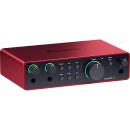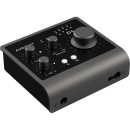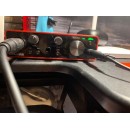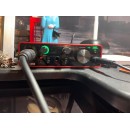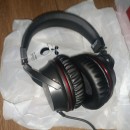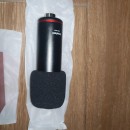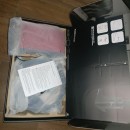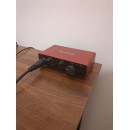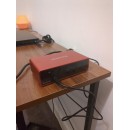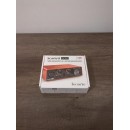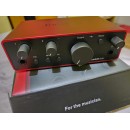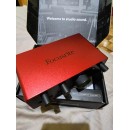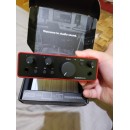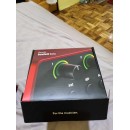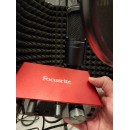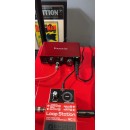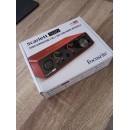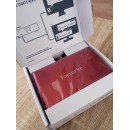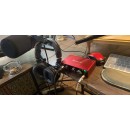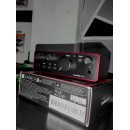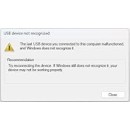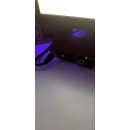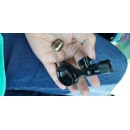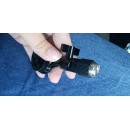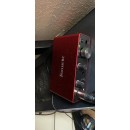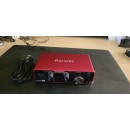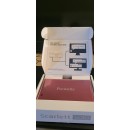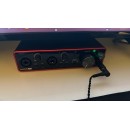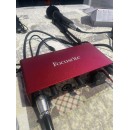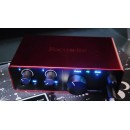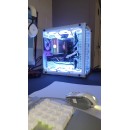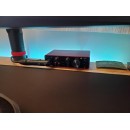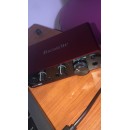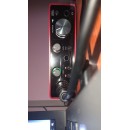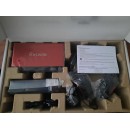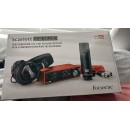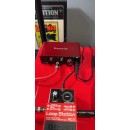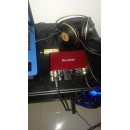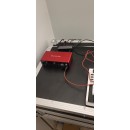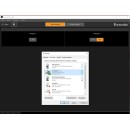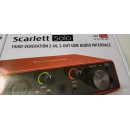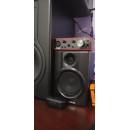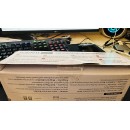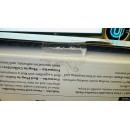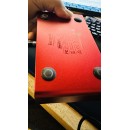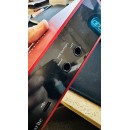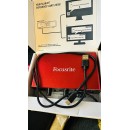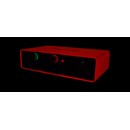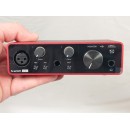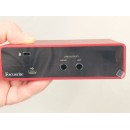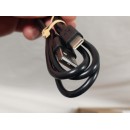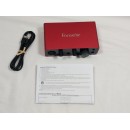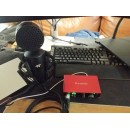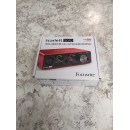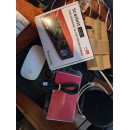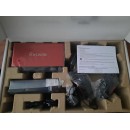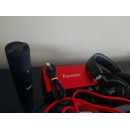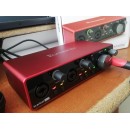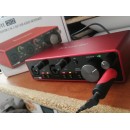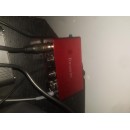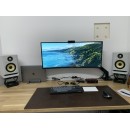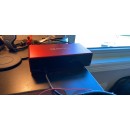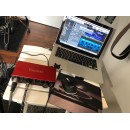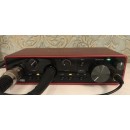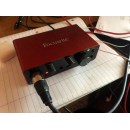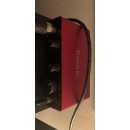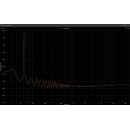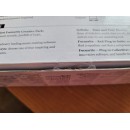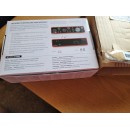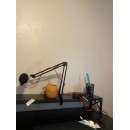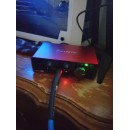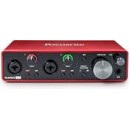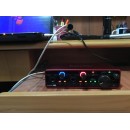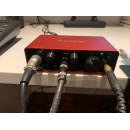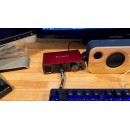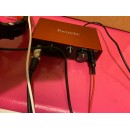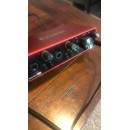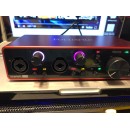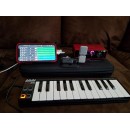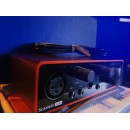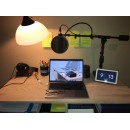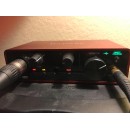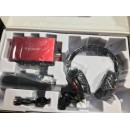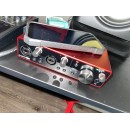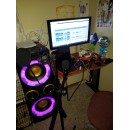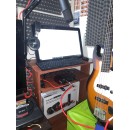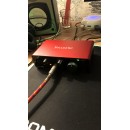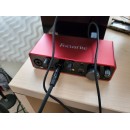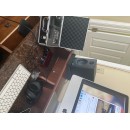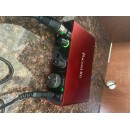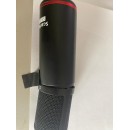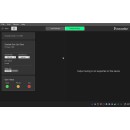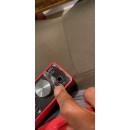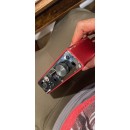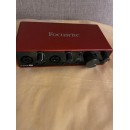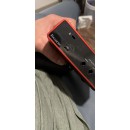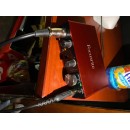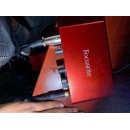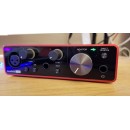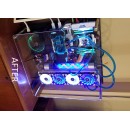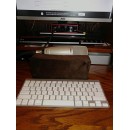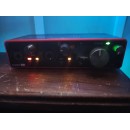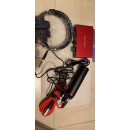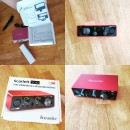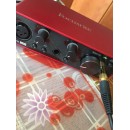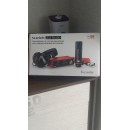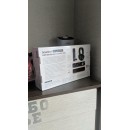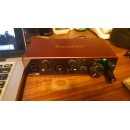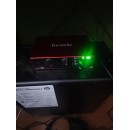Audient iD4 MKII vs Focusrite Scarlett 2i2 (4th Gen): USB-C Audio Interface Showdown
The Focusrite Scarlett 2i2 (4th Gen) continues the legacy of its predecessors with its renowned preamp quality, boasting a dynamic range of 120dB and ultra-low latency performance. It features two upgraded Scarlett mic preamps with Air mode, designed to emulate the classic Focusrite ISA preamp, giving vocals and instruments a brighter, more open sound. The 2i2 also includes two high-headroom instrument inputs and balanced line inputs, making it versatile for various recording scenarios. Its USB-C connectivity ensures fast and reliable data transfer, and it comes bundled with a comprehensive software package, including Ableton Live Lite and a three-month subscription to Avid Pro Tools Artist. The Scarlett 2i2 is known for its user-friendly interface, making it ideal for beginners and experienced users alike.
On the other hand, the Audient iD4 MKII offers a robust build quality and professional-grade audio performance, featuring Audient's renowned Class-A mic preamp and JFET instrument input. The iD4 MKII boasts an impressive 120dB dynamic range and ultra-low latency, similar to the Scarlett 2i2, but it adds some unique features. One standout is the ScrollControl function, which allows the volume knob to be used as a virtual scroll wheel for your DAW and other software, enhancing workflow efficiency. Additionally, the iD4 MKII includes a dual headphone output, making it perfect for collaborative work. The USB-C connectivity ensures seamless compatibility with modern devices, and it also includes a comprehensive software bundle, featuring Cubase LE and the Audient ARC creative hub.
In summary, both the Focusrite Scarlett 2i2 (4th Gen) and the Audient iD4 MKII are excellent choices, each with its own strengths. The Scarlett 2i2 is celebrated for its ease of use, versatile inputs, and comprehensive software package, making it a great all-around option for various recording needs. The Audient iD4 MKII, with its superior build quality, unique ScrollControl feature, and dual headphone outputs, offers a slightly more professional edge, catering to users who prioritize enhanced workflow and collaborative recording. Your choice between the two will ultimately depend on your specific requirements and preferences in a USB-C audio interface.
Detailed Specifications, Pros, and Cons of Audient iD4 MKII and Focusrite Scarlett 2i2 (4th Gen)
| User Rating Based on Analysis of Reviews | |
|---|---|
|
Show More |
| Pros: | |
|---|---|
|
|
| Cons: | |
|---|---|
|
|
| Find Best Price | Find Best Price |
| Key Specs | |
|---|---|
| Channels of I/O | |
| Analog: 2 Inputs / 2 Outputs at 192 kHz |
Analog: 2 Inputs / 2 Outputs at 96 kHz |
| Maximum Sampling Rate | |
| 192 kHz / 24-Bit | 96 kHz / 24-Bit |
| Number of Microphone Inputs | |
| 2 | 1 Preamp |
| Analog Audio I/O | |
| 2x XLR 3-Pin Balanced Mic Input 2x 1/4" TRS Balanced/Unbalanced Line/Hi-Z Input (Front Panel) 2x 1/4" TRS Balanced Monitor Output 1x 1/4" TRS Headphone Output (Front Panel) |
1x Combo XLR-1/4" TRS Balanced Mic/Line Input 1x 1/4" TRS Unbalanced Hi-Z Input (Front Panel) 2x 1/4" TRS Balanced Monitor Output 1x 1/4" TRS Unbalanced Headphone Output (Front Panel) 1x 1/8" / 3.5 mm TRS Unbalanced Headphone Output (Front Panel) |
| Host Connection | |
| 1x USB-C | 1x USB-C |
| OS Compatibility | |
| macOS Windows |
macOS 10.11.6 or Later macOS 11.1 or Later Windows 7 or Later 6 or Later iPadOS |
| Power Requirements | |
| USB Bus Power, USB Power Adapter (Not Included) | USB Bus Power |
Starting with the Focusrite Scarlett 2i2, it offers 2 analog inputs and 2 outputs at a maximum sampling rate of 192 kHz / 24-Bit. It includes 2 microphone inputs and provides a comprehensive set of analog audio I/O options: 2x XLR 3-Pin balanced mic inputs, 2x 1/4" TRS balanced/unbalanced line/Hi-Z inputs, 2x 1/4" TRS balanced monitor outputs, and 1x 1/4" TRS headphone output. The Scarlett 2i2 is designed for compatibility with both macOS and Windows operating systems and connects via a USB-C host connection. It is powered through USB bus power or an optional USB power adapter, which is not included.
In contrast, the Audient iD4 MKII offers 2 analog inputs and 2 outputs at a maximum sampling rate of 96 kHz / 24-Bit. It features only 1 microphone input but includes an analog audio I/O setup of 1x combo XLR-1/4" TRS balanced mic/line input, 1x 1/4" TRS unbalanced Hi-Z input, 2x 1/4" TRS balanced monitor outputs, 1x 1/4" TRS unbalanced headphone output, and an additional 1/8" / 3.5 mm TRS unbalanced headphone output. The iD4 MKII stands out with its broader OS compatibility, supporting macOS 10.11.6 or later, macOS 11.1 or later, Windows 7 or later, and even iPadOS. It also uses a USB-C host connection and is powered solely through USB bus power.
In summary, the Focusrite Scarlett 2i2 (4th Generation) excels with its higher maximum sampling rate, additional microphone input, and a more extensive analog audio I/O setup. On the other hand, the Audient iD4 MKII offers slightly more flexible OS compatibility and includes an extra headphone output, which could be beneficial for specific use cases. Both interfaces connect via USB-C and are powered through USB, making them convenient and portable for various recording environments.
| General | |
|---|---|
| Channels of I/O | |
| Analog: 2 Inputs / 2 Outputs at 192 kHz |
Analog: 2 Inputs / 2 Outputs at 96 kHz |
| Maximum Sampling Rate | |
| 192 kHz / 24-Bit | 96 kHz / 24-Bit |
| Number of Microphone Inputs | |
| 2 | 1 Preamp |
| Input Level Adjustment | |
| 2x Knob | 2x Knob |
| Expansion Slots | |
In terms of channels of I/O, both interfaces provide 2 analog inputs and 2 analog outputs. However, the Focusrite Scarlett 2i2 supports a higher maximum sampling rate of 192 kHz at 24-bit, compared to the Audient iD4 MKII, which supports up to 96 kHz at 24-bit. This higher sampling rate in the Scarlett 2i2 may be beneficial for users seeking the highest possible audio resolution.
Regarding microphone inputs, the Focusrite Scarlett 2i2 offers 2 microphone inputs, whereas the Audient iD4 MKII includes just 1 microphone preamp input. This makes the Scarlett 2i2 more versatile for recording scenarios that require multiple microphones simultaneously, such as recording duets or stereo miking techniques.
Both interfaces feature input level adjustment with 2 knobs, enabling precise control over input gain. Neither interface includes built-in DSP or expansion slots, keeping the design straightforward and focused on core audio recording functions.
In summary, the Focusrite Scarlett 2i2 USB-C Audio Interface (4th Generation) stands out with its higher sampling rate and dual microphone inputs, making it suitable for more complex recording setups. Conversely, the Audient iD4 MKII, while offering a lower sampling rate and fewer microphone inputs, may appeal to users who prioritize simplicity and the renowned Audient preamp quality in a more compact form.
| Signal Processing | |
|---|---|
| Gain/Trim Range | |
| Mic/Line Inputs: Up to +69 dB Hi-Z Inputs: 62 dB |
Mic/Hi-Z Inputs: 58 dB Hi-Z Inputs: 40 dB |
On the other hand, the Audient iD4 MKII USB-C Audio Interface has a gain/trim range of 58 dB for its mic/Hi-Z inputs and 40 dB for its Hi-Z inputs. While this range is slightly more limited compared to the Scarlett 2i2, it still provides sufficient headroom for typical recording scenarios. However, it lacks a pad feature, which could be a limitation when dealing with particularly high-output sources.
Additionally, the iD4 MKII does not include a high-pass filter, which can be a useful feature for reducing low-frequency rumble and noise during recording. In contrast, the Scarlett 2i2 does not have this feature listed either, maintaining parity in this aspect. The iD4 MKII also offers a mute per master functionality, providing additional control over the monitoring environment, a feature not mentioned in the Scarlett 2i2's specs.
In summary, while both interfaces are robust and capable, the Focusrite Scarlett 2i2 offers a broader gain range which could be beneficial for a wider variety of recording applications. The Audient iD4 MKII provides specific control features like mute per master, which may appeal to users needing more immediate control over their monitoring setup.
| Connectivity | |
|---|---|
| Analog Audio I/O | |
| 2x XLR 3-Pin Balanced Mic Input 2x 1/4" TRS Balanced/Unbalanced Line/Hi-Z Input (Front Panel) 2x 1/4" TRS Balanced Monitor Output 1x 1/4" TRS Headphone Output (Front Panel) |
1x Combo XLR-1/4" TRS Balanced Mic/Line Input 1x 1/4" TRS Unbalanced Hi-Z Input (Front Panel) 2x 1/4" TRS Balanced Monitor Output 1x 1/4" TRS Unbalanced Headphone Output (Front Panel) 1x 1/8" / 3.5 mm TRS Unbalanced Headphone Output (Front Panel) |
| Phantom Power | |
| 48 V, Selectable On/Off | 48 V ± 4 V, Selectable On/Off |
| Digital Audio I/O | |
| Host Connection | |
| 1x USB-C | 1x USB-C |
| Host Connection Protocol | |
| USB 2.0 | USB 3.0 / 3.1/3.2 Gen 1 |
| USB (Non-Host) | |
| 1x USB-C (Power Input) | |
| Sync I/O | |
| Network I/O | |
| MIDI I/O | |
The Focusrite Scarlett 2i2 (4th Generation) provides a versatile analog audio I/O configuration with 2x XLR 3-Pin balanced mic inputs and 2x 1/4" TRS balanced/unbalanced line/Hi-Z inputs on the front panel. This makes it suitable for both microphone and instrument recordings. It also features 2x 1/4" TRS balanced monitor outputs and a 1/4" TRS headphone output, all conveniently located on the front panel. For phantom power, the Scarlett 2i2 offers 48V, which is selectable on or off. The device connects to the host via a USB-C connection using USB 2.0 protocol and includes an additional USB-C port for power input. However, it lacks digital audio I/O, sync I/O, network I/O, MIDI I/O, and wireless capabilities.
In contrast, the Audient iD4 MKII USB-C Audio Interface has a more streamlined analog audio I/O setup. It includes 1x combo XLR-1/4" TRS balanced mic/line input and 1x 1/4" TRS unbalanced Hi-Z input on the front panel. For output, it provides 2x 1/4" TRS balanced monitor outputs, a 1/4" TRS unbalanced headphone output, and an additional 1/8" / 3.5 mm TRS unbalanced headphone output, offering greater flexibility for different headphone types. The iD4 MKII also features 48V phantom power with a current specification of ±4 V and 10 mA per channel. It connects to the host via a USB-C connection using USB 3.0 / 3.1/3.2 Gen 1 protocol, but does not include additional USB ports for power input. Similar to the Scarlett 2i2, it lacks digital audio I/O, sync I/O, network I/O, MIDI I/O, and wireless capabilities.
In summary, the Focusrite Scarlett 2i2 (4th Generation) is more comprehensive in terms of input options, making it ideal for users who require multiple mic and instrument connections. The Audient iD4 MKII, on the other hand, offers a simpler yet flexible setup with additional headphone output options and a higher USB protocol, catering to users who prioritize headphone monitoring and higher data transfer speeds. Both interfaces provide essential features like phantom power and balanced monitor outputs but differ in their connectivity and configuration options.
| Performance | |
|---|---|
| Frequency Response | |
| XLR Mic Inputs: 20 Hz to 20 kHz ±0.06 dB 1/4" Line Inputs: 20 Hz to 20 kHz 0.05 dB 1/4" Hi-Z Inputs: 20 Hz to 20 kHz 0.15 dB |
A/D Converters: 10 Hz to 40 kHz ±0.5 dB D/A Converters: 10 Hz to 40 kHz ±0.1 dB Headphone Outputs: 10 Hz to 40 kHz ±0.1 dB Mic, Line Inputs: 10 Hz to 40 kHz ±0.5 dB (Min Gain) Hi-Z Inputs: 10 Hz to 20 kHz ±0.5 dB (Min Gain) |
| Maximum Input Level | |
| XLR Mic: 16 dBu 1/4" Line: 22 dBu 1/4" Hi-Z: 12 dBu |
Mic Inputs: +12 dBu Line Inputs: +21 dBu Hi-Z Inputs: +12 dBu |
| Maximum Output Level | |
| 1/4" Line: +16 dBu |
Headphone Outputs: +5.46 Vrms (600-Ohm Load) |
| Headphone Output Power | |
| 1/4": 32 mW into 33 Ohms 22 mW into 300 Ohms |
223 mW into 30 Ohms (Max) 280 mW into 62 Ohms (Max) 100 mW into 600 Ohms (Max) |
| Impedance | |
| XLR Mic Inputs: 3 Kilohms 1/4" Line Inputs: 60 Kilohms 1/4" Hi-Z Inputs: 1 Megohms 1/4" Line Outputs: 100 Ohms 1/4" Headphone Outputs: < 50 Ohm |
Mic Inputs: 2.8 Kilohms (Balanced) Line Inputs: > 8 Kilohms (Balanced) |
| Dynamic Range | |
| XLR Mic Inputs: 116 dBA 1/4" Line Inputs: 115.2 dBA 1/4" Hi-Z Inputs: 113 dBA 1/4" Line Outputs: 120 dB 1/4" Headphone: 112 dB (at 33 Ohms) 115 dB (at 300 Ohms) Digital A/D Converters: 120 dB Digital D/A Converters: 130 dBA |
A/D Converters: 120 dB (A-Weighted) D/A Converters: 125.5 dB (A-Weighted) Headphone Outputs: 125.5 dB (A-Weighted) |
| THD+N | |
| XLR Mic Inputs: -100 dB (at 8 dB Gain) 1/4" Line Inputs: -100 dB (at 8 dB Gain) 1/4" Hi-Z Inputs: -80 dB (at Minimum Gain) 1/4" Line Outputs: -109 dB 1/4" Headphone Outputs: -99 dB (at 33 Ohms) -108 dB (at 300 Ohms) Digital A/D Converters: -110 dB Digital D/A Converters: -115 dB |
Mic/Line Inputs: 0.0017% (at 0 dBu) Hi-Z Inputs: 0.1% (at 0 dBu) A/D Converters: < 0.001% (at -1 dBFS) D/A Converters: < 0.0006% (at -1 dBFS) Headphone Outputs: < 0.0009% (at -1 dBFS) |
| EIN | |
| XLR Mic Inputs: -127 dBu A-Weighted |
Mic/Line Inputs: -129 dB A-Weighted |
Frequency Response:
The Focusrite Scarlett 2i2 offers a frequency response of 20 Hz to 20 kHz for its XLR mic, 1/4" line, and Hi-Z inputs with minimal deviation, ensuring consistent audio quality across the audible spectrum. In contrast, the Audient iD4 MKII provides a broader frequency range, from 10 Hz to 40 kHz for its A/D and D/A converters and headphone outputs, and 10 Hz to 20 kHz for its Hi-Z inputs. This extended range may appeal to users seeking high-fidelity audio reproduction beyond the standard human hearing range.
Maximum Input Level: The maximum input levels for the Scarlett 2i2 are 16 dBu for XLR mic, 22 dBu for 1/4" line, and 12 dBu for Hi-Z inputs. The Audient iD4 MKII supports slightly lower maximum input levels of +12 dBu for mic and Hi-Z inputs and +21 dBu for line inputs, which indicates a marginally lower tolerance for high-input signals compared to the Scarlett 2i2.
Maximum Output Level: The Scarlett 2i2 has a maximum line output level of +16 dBu. The Audient iD4 MKII's headphone outputs can achieve up to +5.46 Vrms into a 600-Ohm load, suggesting it can drive high-impedance headphones effectively with significant power output.
Headphone Output Power: The Scarlett 2i2 provides 32 mW into 33 Ohms and 22 mW into 300 Ohms. Meanwhile, the iD4 MKII delivers considerably higher power: 223 mW into 30 Ohms, 280 mW into 62 Ohms, and 100 mW into 600 Ohms, making it a better choice for users with power-hungry headphones.
Impedance: The Scarlett 2i2 features an impedance of 3 Kilohms for XLR mic inputs, 60 Kilohms for 1/4" line inputs, and 1 Megohm for Hi-Z inputs, with 100 Ohms for line outputs and less than 50 Ohms for headphone outputs. The iD4 MKII has an impedance of 2.8 Kilohms for mic inputs and greater than 8 Kilohms for line inputs, indicating a similar but slightly lower range of input impedance.
Dynamic Range: The Scarlett 2i2 shows a dynamic range of 116 dBA for XLR mic inputs, 115.2 dBA for 1/4" line inputs, 113 dBA for Hi-Z inputs, and 120 dB for line outputs. Its headphone output offers 112 dB at 33 Ohms and 115 dB at 300 Ohms, with digital A/D and D/A converters at 120 dB and 130 dBA, respectively. The iD4 MKII boasts a dynamic range of 120 dB for A/D converters and 125.5 dB for D/A converters, with headphone outputs also rated at 125.5 dB, indicating superior dynamic range performance.
THD+N: The Scarlett 2i2 has THD+N ratings of -100 dB for XLR mic and 1/4" line inputs, -80 dB for Hi-Z inputs, -109 dB for line outputs, and varying headphone outputs of -99 dB at 33 Ohms and -108 dB at 300 Ohms. The iD4 MKII exhibits THD+N of 0.0017% for mic/line inputs, 0.1% for Hi-Z inputs, less than 0.001% for A/D converters, less than 0.0006% for D/A converters, and less than 0.0009% for headphone outputs, showcasing lower distortion levels.
EIN: The Scarlett 2i2's XLR mic inputs have an EIN of -127 dBu A-Weighted. The iD4 MKII offers slightly better performance with mic/line inputs at -129 dB A-Weighted.
In summary, while both interfaces are highly capable, the Audient iD4 MKII stands out with its broader frequency response, higher dynamic range, and superior headphone output power. The Focusrite Scarlett 2i2, however, offers slightly better maximum input levels and a robust performance across its specifications, making it a versatile choice for various recording needs.
| Digital Audio | |
|---|---|
| Sample Rates | |
| 44.1 / 48 / 88.2 / 96 / 176.4 / 192 kHz | 44.1 / 48 / 88.2 / 96 kHz |
| Bit Depths | |
| 24-Bit | 24-Bit |
| Sync Sources | |
| Internal | Internal |
The Focusrite Scarlett 2i2 offers a wider range of sample rates, supporting 44.1, 48, 88.2, 96, 176.4, and 192 kHz. This makes it more versatile for different recording needs and professional audio projects that may require higher sample rates. Both interfaces support a bit depth of 24-bit, ensuring high-resolution audio recording. The Scarlett 2i2 relies on internal sync sources for clocking.
On the other hand, the Audient iD4 MKII supports sample rates up to 96 kHz, which is sufficient for most standard recording tasks, though it does not reach the maximum 192 kHz offered by the Scarlett 2i2. The iD4 MKII also maintains a 24-bit depth, ensuring high-quality audio. It features a dBFS reference level of +12 dBu = 0 dBFS, which is a useful specification for understanding its headroom and dynamic range. The interface showcases impressive latency performance, with 0.65 ms at 44.1 kHz and 0.31 ms at 96 kHz, although this is dependent on buffer size and input-to-output routing. Similar to the Scarlett, it uses internal sync sources for clocking.
In summary, the Focusrite Scarlett 2i2 (4th Generation) offers broader sample rate options, making it a more flexible choice for various recording environments. The Audient iD4 MKII, while limited to a maximum of 96 kHz sample rate, provides detailed latency information and a specific dBFS reference level, which can be crucial for users focused on precise audio level management and low latency performance.
| Audio Storage & Playback |
|---|
| Compatibility | |
|---|---|
| OS Compatibility | |
| macOS Windows |
macOS 10.11.6 or Later macOS 11.1 or Later Windows 7 or Later 6 or Later iPadOS |
On the other hand, the Audient iD4 MKII USB-C Audio Interface is compatible with macOS 10.11.6 or later, macOS 11.1 or later, Windows 7 or later, and iPadOS. It also supports both iPad and iPhone compatibility, providing greater flexibility for mobile device users. Additionally, the Audient iD4 MKII requires a minimum of a 1.6 GHz Intel Core 2 processor and 1 GB of RAM, and it mandates an available USB-C port and an internet connection for registration and software/driver downloads.
In summary, while both interfaces support macOS and iPadOS, the Audient iD4 MKII offers broader compatibility, including iPhone support and specific hardware and software requirements, making it potentially more versatile for a range of users and devices. The Focusrite Scarlett 2i2, while slightly more limited in mobile device compatibility, still provides robust support for macOS, Windows, and iPadOS users.
| Power | |
|---|---|
| Power Requirements | |
| USB Bus Power, USB Power Adapter (Not Included) | USB Bus Power |
On the other hand, the Audient iD4 MKII strictly relies on USB Bus Power for its operation. This means it draws power directly from the connected USB port of the computer or device, simplifying its setup and reducing the need for additional power accessories. This design choice emphasizes ease of use and portability, allowing users to quickly connect and start recording without worrying about additional power sources.
In summary, the Focusrite Scarlett 2i2 offers more versatility in power options with its support for USB Bus Power, USB Power Adapter, and AC/DC Power Adapter, while the Audient iD4 MKII focuses on simplicity and portability by utilizing only USB Bus Power.
| Physical | |
|---|---|
| Dimensions | |
| 7.1 x 4.6 x 1.87" / 18 x 11.7 x 4.75 cm | 5.2 x 4.7 x 2.4" / 13.3 x 12 x 6 cm (Including Controls and Protrusions) |
| Weight | |
| 1.3 lb / 595.0 g | 2.2 lb / 1.0 kg |
In terms of dimensions, the Focusrite Scarlett 2i2 measures 7.1 x 4.6 x 1.87 inches (18 x 11.7 x 4.75 cm), making it relatively compact. Comparatively, the Audient iD4 MKII comes in at 5.2 x 4.7 x 2.4 inches (13.3 x 12 x 6 cm), including controls and protrusions. While both devices are portable, the Scarlett 2i2 is slightly longer and narrower, whereas the iD4 MKII is slightly shorter but thicker.
Regarding weight, the Focusrite Scarlett 2i2 weighs 1.3 lb (595.0 g), making it lighter and more convenient for mobile setups. On the other hand, the Audient iD4 MKII weighs 2.2 lb (1.0 kg), which is almost double the weight of the Scarlett 2i2. This additional weight may contribute to a more robust build but could be a consideration for users needing a more portable solution.
One unique feature of the Audient iD4 MKII is its anti-theft feature, specifically the Kensington Security Slot. This feature allows users to secure the device in environments where theft might be a concern, such as public studios or educational settings. The Scarlett 2i2 does not offer this particular security feature.
Both devices interface with USB-C, ensuring modern connectivity and fast data transfer. However, the difference in dimensions, weight, and the presence of an anti-theft feature on the Audient iD4 MKII provides potential users with distinct choices depending on their specific needs and use cases.
| Packaging Info | |
|---|---|
| Package Weight | |
| 1.9 lb | 1.92 lb |
| Box Dimensions (LxWxH) | |
| 8.2 x 7 x 2.6" | 7.5 x 6 x 3.5" |
The Focusrite Scarlett 2i2 has a package weight of 1.9 lb and its box dimensions are 8.2 x 7 x 2.6". These dimensions indicate a compact and lightweight design, making it a portable choice for musicians and producers who need to move their setup frequently. The Scarlett 2i2 is known for its high-quality preamps and ease of use, making it a staple for both beginners and seasoned professionals.
On the other hand, the Audient iD4 MKII has a slightly heavier package weight of 1.92 lb and box dimensions of 7.5 x 6 x 3.5". While the weight difference is negligible, the dimensions suggest a slightly bulkier design in terms of height, which could offer a more robust build and potentially more durable housing. The Audient iD4 MKII is praised for its exceptional audio quality and solid build, often favored by those who prioritize sound fidelity and hardware durability.
Both interfaces utilize USB-C connectivity, ensuring fast data transfer and compatibility with modern devices. However, users might prefer one over the other based on the slight differences in dimensions and design considerations that could affect portability and setup preferences.
| Customer Images | |
|---|---|
| Videos | |
|---|---|
|
|
|
